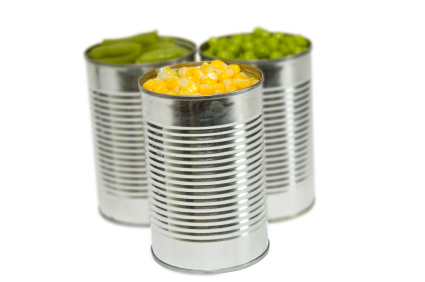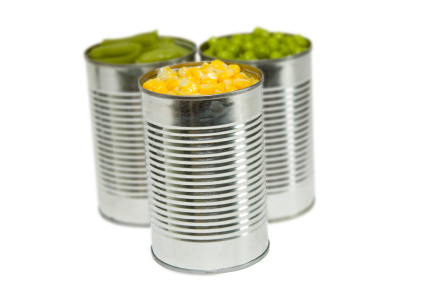 On the heels of Canada’s recently announced ban on bisphenol-A (BPA), The New York Times has a substantial report reviewing the state of the science regarding the safety of this substance. Used primarily to line food and drink cans, some studies have shown BPA to be a hormone disruptor and a potential factor in the rise of obesity. Even the FDA has acknowledged we should reduce our exposure to it.
On the heels of Canada’s recently announced ban on bisphenol-A (BPA), The New York Times has a substantial report reviewing the state of the science regarding the safety of this substance. Used primarily to line food and drink cans, some studies have shown BPA to be a hormone disruptor and a potential factor in the rise of obesity. Even the FDA has acknowledged we should reduce our exposure to it.
The Times piece is dedicated to comments from scientists, rather than from industry spokespeople, which is all to the good, though I’m not crazy about the headline: “In Feast of Data on BPA Plastic, No Final Answer.” The good news is that the thrust of the article undercuts this declaration quite a bit.
It’s true that the piece is chock full of scientific circumspection — many scientists are waiting for definitive results before declaring an unequivocal position on the BPA controversy, including whether low-dose exposure to the chemical truly represents a health risk. But most scientists quoted in the article chalked up much of the uncertainty to details of the experimental techniques used, rather than to real doubts about the underlying hypotheses. In fact, the only denials mentioned were from industry and the Republican party — and no corporate or GOP spokesperson seemed willing to offer a quote on the subject.
The real takeaway from this latest review is that just about everyone is waiting for the completion of the two-year, government-sponsored National Institute of Environmental Health Sciences safety studies that are currently under way. As Times reporter Denise Grady put it, “disputes arise in part because scientists from different disciplines — endocrinologists versus toxicologists, academic researchers versus those at regulatory agencies — do research in different ways that can make findings hard to reconcile.” Once again: It’s the process, not the facts themselves, that keeps the BPA “debate” alive.
For this new research, scientists will have to follow strict experimental guidelines (over which there has been some controversy). The hope is that the new results will be both consistent and comparable, so that when the studies are complete, we’ll finally get the “answer” on BPA.
But the article makes one fundamental, and understandable, mistake. By focusing on BPA, it indirectly supports the industry insistence that BPA’s safety must stand or fall on its own merits. In other words, if BPA doesn’t represent on its own an overwhelming threat to human health, then it shouldn’t be banned.
Grady acknowledges in passing, but gives short shrift to, the sea of endocrine disruptors that surround us. Chemicals that are just as ubiquitous as BPA — pesticides like atrazine, which are endemic in the water supply of large parts of the country; common sunscreen ingredients like oxybenzone; even other plastic ingredients like phthalates — are also hormone disruptors. The real risk they represent is in combination, not necessarily in isolation. And when they are addressed in isolation, it’s much easier for industry to defend an individual chemical against the attacks: “It’s not all BPA’s fault! The risk is very modest,” they might argue. “So don’t ban it! Ban some other chemical!”
That’s why some scientists, and some environmentalists, are rightly treating BPA as a member of a dangerous and disruptive class, not as Public Enemy Number One.
I was also a bit disappointed at the continued acceptance of the industry line that there are no good alternatives for BPA from a food safety perspective, and thus we must continue to use it in canned-food linings (which is the primary way we are exposed to it). This is really about industry laziness and opposition to regulation. Even if you ignore the organic food companies like Eden and Muir Glen (owned by General Mills, for goodness’ sake) that are already using BPA alternatives, you can’t ignore this (via Food Production Daily):
A new polymer coating suitable for use as a lining in food and beverage cans is free from bisphenol A (BPA) and is produced using around 60 percent less energy than traditional epoxy materials, said the US company behind the product.
Design Analysis Inc, of Jacksonville, Florida, said the PolyKoat thermoplastic polyester coating is free of all volatile organic compounds (VOCs) and is a greener alternative to competitive food can linings. It can be attached directly onto a range of hot and cold-rolled metal packaging substrates; galvanised and tin-free steel and aluminium.
The coating performs as well as epoxy linings with vastly reduced production costs and contains no BPA, company commercial vice president Jeff Sawka told FoodProductionDaily.com.
Oh, and the new polymer already has FDA “food contact” approval. In some ways, the “there’s no alternative!” argument is the most powerful one that industry has. Congress is all too easily swayed by complaints of inconvenience and impossibility from corporations — and all too unmoved by safety concerns for everyday Americans. Nor do the large food companies seem interested in doing the right thing on this one.
But once a viable BPA alternative gets a little publicity, the question will turn to “why don’t you just use this stuff instead” — and the industry’s last real pro-BPA leg will get kicked out from under it.



